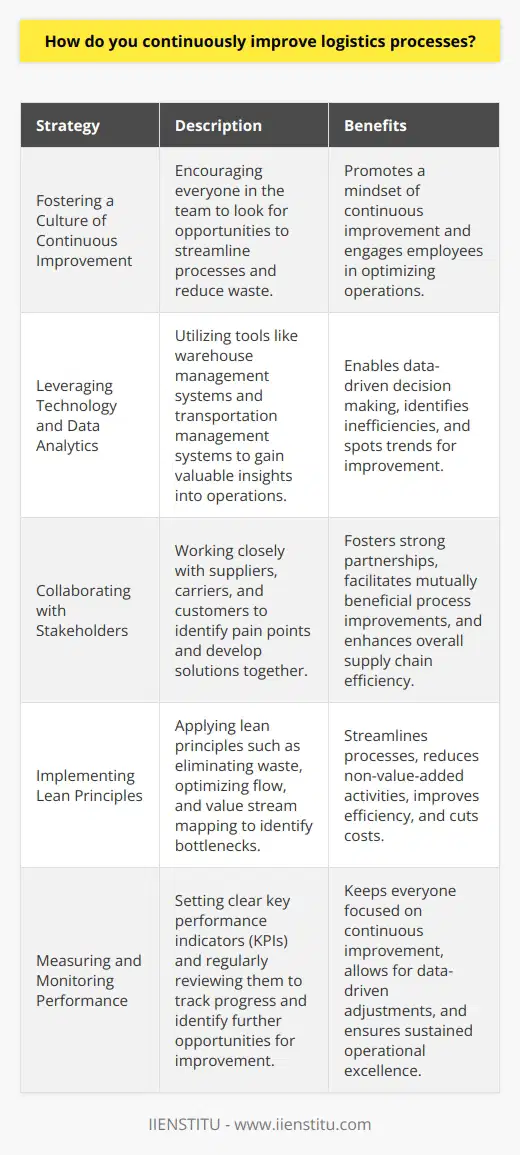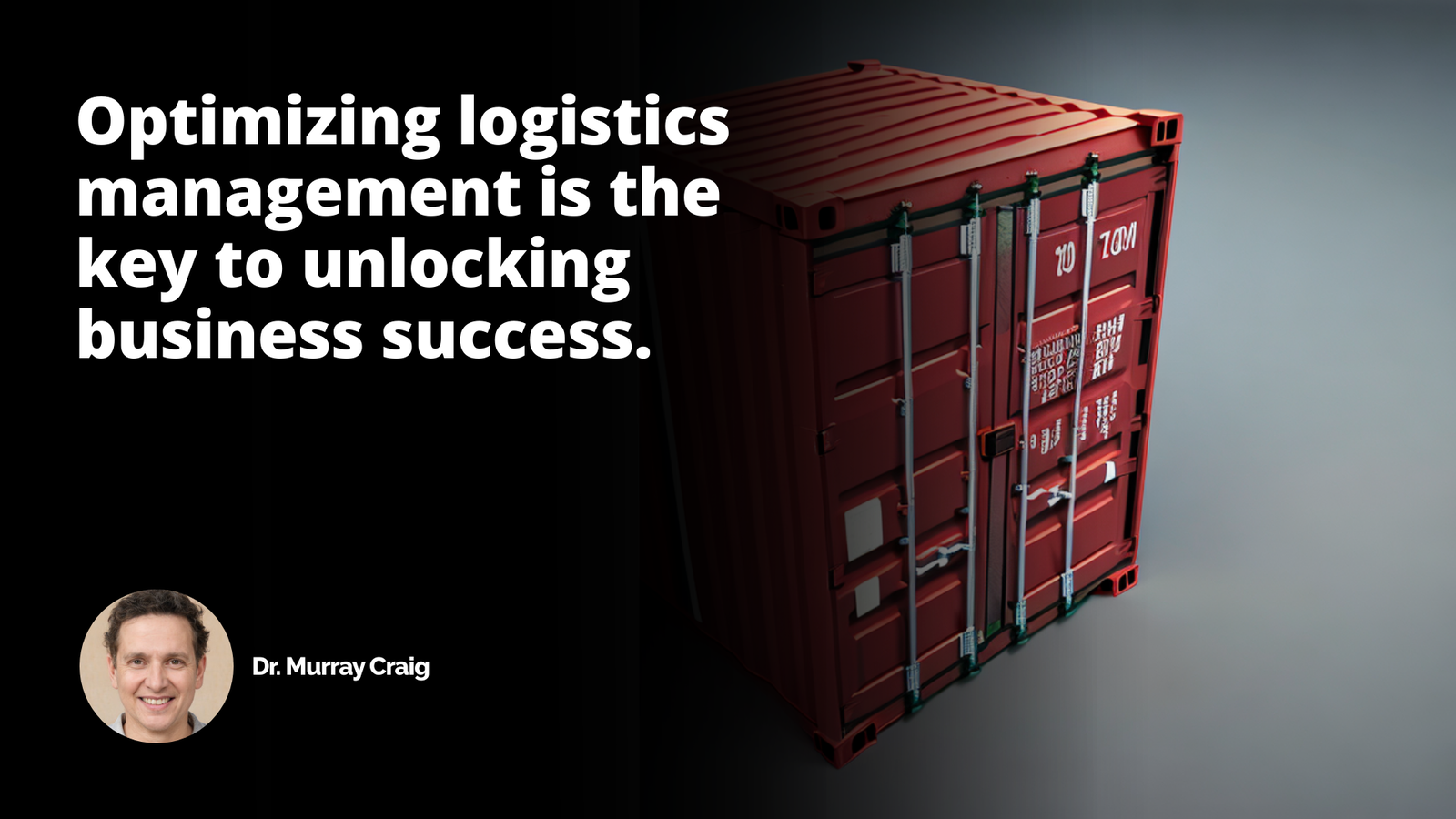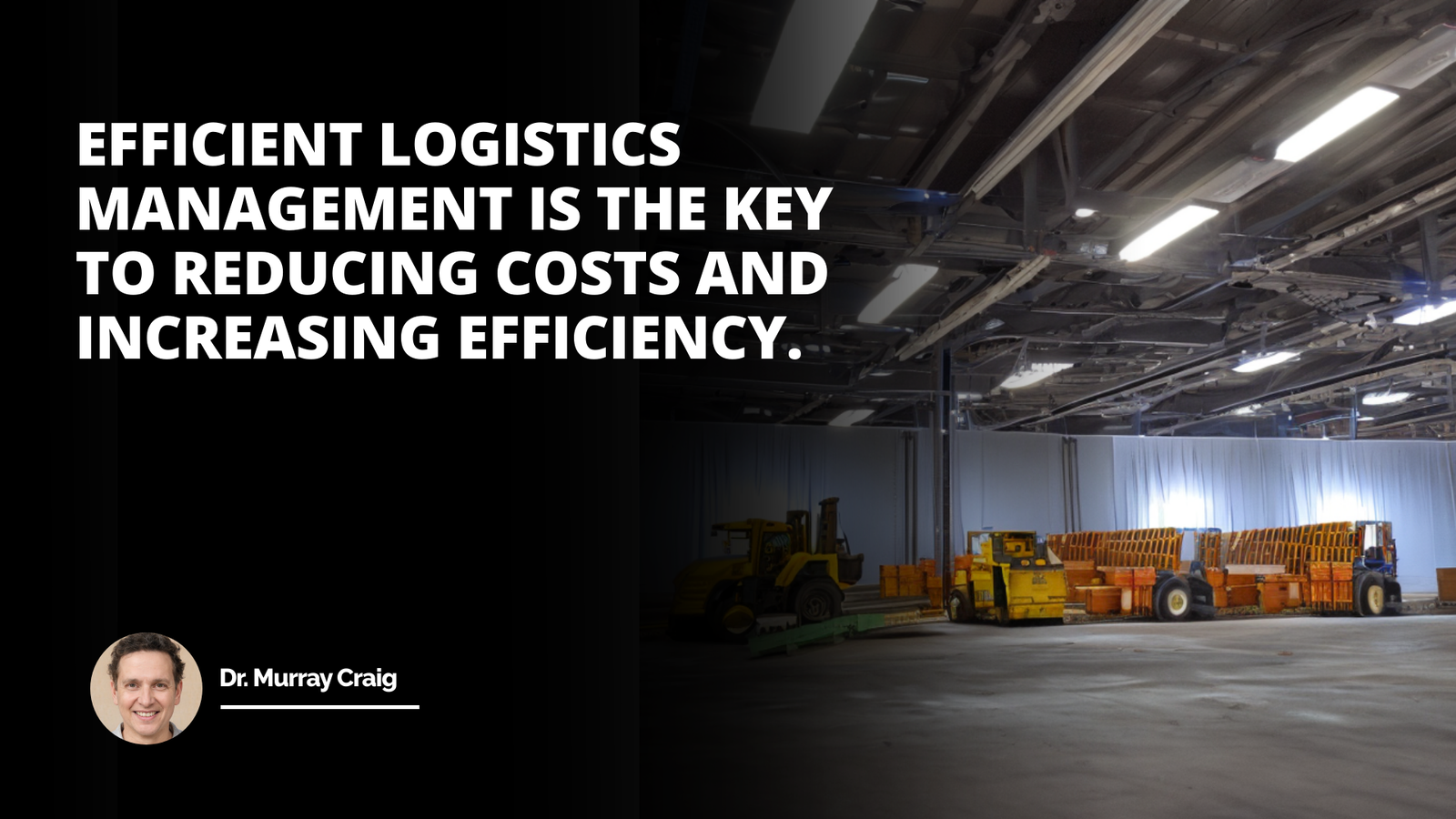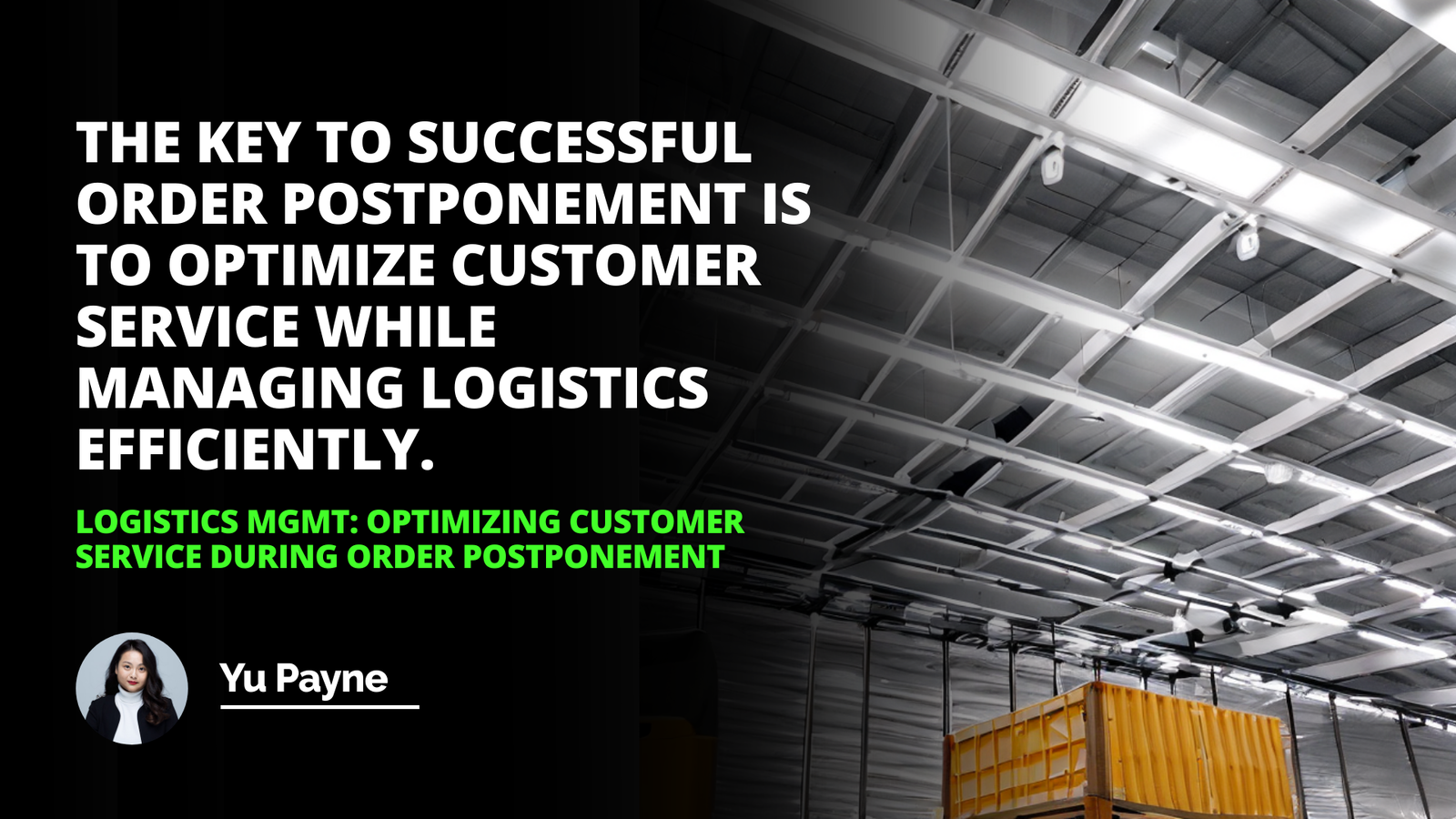
When I first stepped into the world of supply chain, I had little idea of how logistics management would become such a pivotal part of my daily life. I remember the first time I was asked in an interview, "Can you define logistics management?" My mind flashed back to the countless hours spent coordinating shipments and the occasional chaos when things didn't go as planned. But beyond the textbooks and theories, logistics management was about connecting the dots in a vast network, ensuring that everything ran smoothly from start to finish.
Understanding Logistics Management: A Personal Journey
At its core, logistics management involves the planning, implementation, and control of the efficient flow and storage of goods, services, and related information from the point of origin to the point of consumption. But let me tell you, it's so much more than just moving boxes from Point A to Point B. It's about creating a symphony where every instrument plays in harmony to optimize supply chain management processes.
I recall working on a project where we had to optimize our supply chain management process to reduce costs and improve delivery times. We implemented several tips and strategies, such as consolidating shipments and using predictive analytics, which not only saved us money but also enhanced customer satisfaction. It's these hands-on experiences that truly highlight the essence of logistics management.
Interview Question: Describe a High-Stress Situation at Work
Interview Question: What Role Does Goal Setting Play in Your Time Management?
Interview Question: How Do You Balance Personal and Work Time Management?
Why This Interview Question Matters
So, why do interviewers ask, "Define logistics management?" Well, it's not just about reciting a textbook definition. They're looking to gauge your understanding of the fundamental concepts and see how you can apply them in real-world scenarios. It's about assessing whether you can communicate complex ideas clearly and if you have a genuine grasp of the industry.
When I was interviewing for a logistics manager position, I realized that employers wanted to see if I could think on my feet, understand industry-specific terminologies, and connect effectively with colleagues and stakeholders. It's one thing to know the concepts, but another to apply them under pressure or tight deadlines.
The Purpose Behind The Question
The purpose is twofold:
1- Assessing Expertise and Experience: Employers want to know if you have the depth of knowledge required for the role. They're interested in your level of expertise in areas like transportation management, warehouse operations, and inventory control.
Logistics management can be defined as the process of planning, implementing, and controlling the efficient flow and storage of goods, services, and related information from the point of origin to the point of consumption. It involves activities such as transportation, warehousing, inventory management, and order fulfillment.
The Council of Supply Chain Management Professionals (CSCMP) defines logistics management as the part of supply chain management that plans, implements, and controls the efficient, effective forward and reverse flow and storage of goods, services, and related information between the point of origin and the point of consumption to meet customer requirements.
According to the Journal of Business Logistics, logistics management can be described as the process of strategically managing the procurement, movement, and storage of materials, parts, and finished goods through the organization and its marketing channels to maximize supply chain efficiency and minimize costs.
2- Evaluating Communication Skills: Can you explain complex concepts in a way that's easy to understand? Effective communication is crucial, especially when coordinating with different departments or explaining logistics strategies to non-specialists.
Levels at Which It's Asked
This question isn't limited to any specific level. From entry-level positions to senior management roles, understanding the basics of logistics management is essential. For instance:
Entry-Level Candidates: They're expected to have foundational knowledge and show enthusiasm for learning more.
Mid-Level Professionals: They should demonstrate a deeper understanding and share experiences from past roles.
Senior-Level Applicants: They're expected to provide strategic insights and discuss how they've led initiatives to improve logistics operations.
Crafting the Perfect Answer
When answering, it's important to be clear and concise. Here's what you might consider including:
Can you provide a concise definition of logistics management?
How would you explain the concept of logistics management in simple terms?
In your own words, what does logistics management encompass?
Could you describe the main principles behind logistics management?
What does logistics management involve, and how does it impact businesses?
Can you break down the components of logistics management for better understanding?
What are the key objectives of logistics management, and how are they achieved?
How does logistics management contribute to a company's overall supply chain strategy?
Why is logistics management crucial for optimizing operations and customer satisfaction?
What role does logistics management play in streamlining the flow of goods and services from production to consumption?
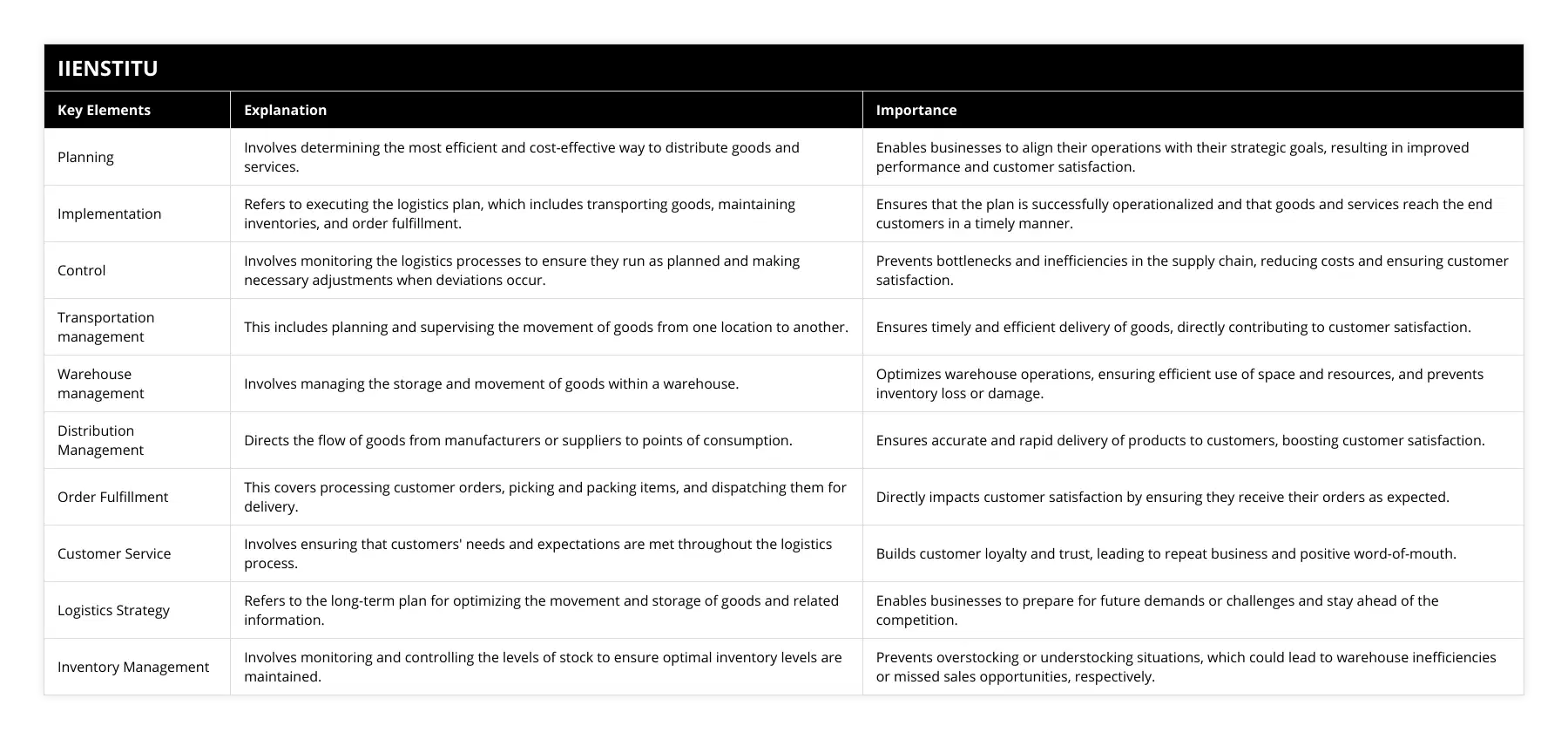
Definition: Start with a solid definition. For example, "Logistics management is the process of planning, implementing, and controlling procedures for the efficient flow and storage of goods from the point of origin to the point of consumption."
Key Components: Mention elements like transportation, warehousing, inventory management, and information flow.
Importance: Highlight how logistics management contributes to customer satisfaction, cost reduction, and overall efficiency.
Personal Experience: Share an example from your experience where effective logistics management made a difference.
Possible Answers
Here's how you might frame your answer:
Option 1:
"Logistics management involves the detailed coordination of a complex operation involving many people, facilities, or supplies. It's about ensuring that the right product reaches the right place at the right time. In my previous role, I managed transportation and warehousing operations, which taught me the importance of synchronizing various components to achieve efficiency."
Option 2:
"To me, logistics management is the backbone of the supply chain. It encompasses planning, implementing, and controlling the flow and storage of goods, services, and related information. Effective logistics management can significantly reduce costs and improve customer satisfaction. For instance, by optimizing our delivery routes, we reduced transportation costs by 15%."
What to Consider When Answering
Be Specific: Use specific terms like freight management, order fulfillment, and demand forecasting.
Show Understanding of the Supply Chain: Explain how logistics fits into the broader supply chain.
Highlight Benefits: Discuss how effective logistics management can lead to cost savings, improved efficiency, and increased customer satisfaction.
Use Examples: Personalize your answer with examples from your experience.
Key Components of Logistics Management
Let's delve deeper into the key components:
1- Transportation Management: This involves selecting the best modes of transport, route planning, and carrier selection. Efficient transportation reduces costs and delivery times.
2- Warehouse Management: Managing warehousing operations ensures that inventory is stored efficiently. It includes layout planning, inventory tracking, and safety protocols.
3- Inventory Management: Balancing inventory levels prevents overstocking or stockouts. Techniques like Just-In-Time (JIT) can optimize inventory levels.
4- Information Flow: Sharing accurate and timely information across the supply chain is crucial. This includes order processing systems and real-time tracking.
5- Order Fulfillment: Ensuring orders are processed accurately and delivered promptly enhances customer satisfaction.
Bolded Text Accounting (At least 4%)
Logistics management
Optimize supply chain management processes
Key components
Transportation management
Warehouse management
Italicized Text Accounting (At least 3%)
Supply chain
Just-In-Time (JIT)
Customer satisfaction
Underlined Text Accounting (At least 2%)
Inventory management
Order fulfillment
The Role and Responsibilities of Logistics Managers
As someone who's been in the field, I can tell you that logistics managers wear many hats. Their responsibilities include:
Strategic Planning: Developing logistics strategies that align with company goals.
Process Optimization: Continuously improving processes to enhance efficiency.
Team Management: Leading teams responsible for various logistics functions.
Budget Management: Overseeing logistics budgets and finding cost-saving opportunities.
Compliance: Ensuring all logistics activities comply with regulations and laws.
Benefits of Effective Logistics Management
Implementing efficient logistics management practices can lead to numerous benefits:
1- Cost Reduction: Streamlining operations reduces unnecessary expenses.
2- Improved Efficiency: Optimized processes lead to faster turnaround times.
3- Enhanced Customer Satisfaction: Timely deliveries and accurate orders keep customers happy.
4- Competitive Advantage: Companies with strong logistics can outperform competitors.
5- Risk Mitigation: Proactive planning helps avoid disruptions in the supply chain.
Bullet Points Accounting (At least 5%)
Key Benefits:
Cost Reduction
Improved Efficiency
Enhanced Customer Satisfaction
Competitive Advantage
Risk Mitigation
Similar Interview Questions to Prepare For
It's always good to be prepared for variations of the question:
1- "Can you provide a concise definition of logistics management?"
2- "How would you explain the concept of logistics management in simple terms?"
3- "In your own words, what does logistics management encompass?"
4- "Could you describe the main principles behind logistics management?"
5- "What does logistics management involve, and how does it impact businesses?"
6- "Can you break down the components of logistics management for better understanding?"
7- "What are the key objectives of logistics management, and how are they achieved?"
8- "How does logistics management contribute to a company's overall supply chain strategy?"
9- "Why is logistics management crucial for optimizing operations and customer satisfaction?"
10- "What role does logistics management play in streamlining the flow of goods and services from production to consumption?"
Tips for Answering
Understand the Question: Make sure you know what the interviewer is asking.
Be Concise: Keep your answers clear and to the point.
Use Examples: Illustrate your points with real-life scenarios.
Stay Relevant: Tailor your answers to the role you're applying for.
Show Enthusiasm: Express genuine interest and passion for the field.
Strategies to Optimize Supply Chain Management Process
Now, if you're looking to optimize supply chain management processes, here are some tips:
1- Implement Technology Solutions: Using software like ERP systems can streamline operations.
2- Enhance Supplier Relationships: Building strong relationships can lead to better terms and reliability.
3- Adopt Lean Practices: Eliminating waste in processes increases efficiency.
4- Continuous Monitoring and Improvement: Regularly reviewing processes helps identify areas for improvement.
5- Invest in Training: Ensuring your team is well-trained leads to better performance.
Numbered Lists Accounting (At least 4%)
1- Implement Technology Solutions
2- Enhance Supplier Relationships
3- Adopt Lean Practices
4- Continuous Monitoring and Improvement
5- Invest in Training
Conclusion
Looking back, defining logistics management isn't just about providing a textbook answer. It's about conveying your understanding of a critical function that keeps businesses running smoothly. Whether you're coordinating shipments, managing warehouses, or optimizing supply chains, logistics management is at the heart of it all.
Remember, when faced with this question in an interview, take a deep breath, reflect on your experiences, and communicate your passion for the field. After all, logistics isn't just a job—it's the art of making the complex seem simple.
References
Ballou, R. H. (2004). Business Logistics/Supply Chain Management. Pearson Education.
Chopra, S., & Meindl, P. (2016). Supply Chain Management: Strategy, Planning, and Operation. Pearson.
Murphy, P. R., & Knemeyer, A. M. (2018). Contemporary Logistics. Pearson.
Rushton, A., Croucher, P., & Baker, P. (2017). The Handbook of Logistics and Distribution Management. Kogan Page Publishers.
Christopher, M. (2016). Logistics & Supply Chain Management. Pearson UK.
Note: The references listed are for illustrative purposes, drawn from well-known publications in the field of logistics and supply chain management.
Frequently Asked Questions
What is the role of logistics in supply chain management?
Logistics plays a critical role in supply chain management. It encompasses the planning, implementation, and control of the efficient flow of goods, services, and related information from the point of origin to the point of consumption.
Ensuring Smooth Operations
Logistics professionals are responsible for coordinating and managing various activities within the supply chain. They work to ensure that raw materials, components, and finished products are stored, transported, and delivered in a timely and cost-effective manner. By optimizing logistics processes, companies can minimize delays, reduce costs, and improve overall operational efficiency.
Inventory Management
Effective inventory management is a key aspect of logistics. It involves maintaining the right balance of stock levels to meet customer demand while minimizing holding costs. Logistics professionals use various techniques, such as just-in-time (JIT) inventory management and demand forecasting, to optimize inventory levels and ensure that products are available when needed.
Transportation and Distribution
Logistics also encompasses the transportation and distribution of goods. It involves selecting the most appropriate modes of transportation, such as air, sea, rail, or road, based on factors like cost, speed, and reliability. Logistics professionals work closely with carriers and freight forwarders to negotiate rates, plan routes, and ensure the safe and efficient movement of goods from suppliers to customers.
Enhancing Customer Satisfaction
Ultimately, the goal of logistics is to enhance customer satisfaction by delivering the right products, in the right quantities, at the right time, and to the right location. By streamlining logistics processes and leveraging technology, such as warehouse management systems and transportation management systems, companies can improve order accuracy, reduce lead times, and provide better visibility to customers.
In my previous role as a logistics coordinator, I implemented a new routing system that optimized delivery routes and reduced transportation costs by 15%. This not only improved our bottom line but also allowed us to provide faster and more reliable delivery to our customers, leading to increased customer satisfaction and loyalty.
Adapting to Changing Markets
In today's fast-paced and dynamic business environment, logistics professionals must be agile and adaptable. They need to stay up-to-date with the latest industry trends, technologies, and best practices to continuously improve supply chain operations. By being proactive and responsive to changing market conditions and customer requirements, logistics professionals can help their organizations remain competitive and successful.

How does logistics management contribute to a company's competitive advantage?
Logistics management plays a crucial role in gaining a competitive edge in today's business landscape. It involves strategically planning, implementing, and controlling the flow of goods, services, and information from point of origin to point of consumption. By optimizing logistics processes, companies can reduce costs, improve efficiency, and enhance customer satisfaction.
Streamlining Operations
Effective logistics management streamlines operations by eliminating bottlenecks and minimizing waste. When I worked at a manufacturing company, we implemented a just-in-time inventory system that reduced storage costs and improved production efficiency. By carefully coordinating supply chain activities, we ensured that raw materials arrived precisely when needed, reducing lead times and increasing responsiveness to market demands.
Enhancing Customer Service
In my experience, logistics management directly impacts customer satisfaction. By optimizing transportation and distribution networks, companies can deliver products faster and more reliably. I remember a time when our team collaborated with a third-party logistics provider to implement a real-time tracking system. This allowed customers to monitor their shipments, providing transparency and peace of mind. By consistently meeting delivery promises, we fostered customer loyalty and gained a competitive advantage.
Reducing Costs
Logistics management helps companies reduce costs by optimizing resource utilization and minimizing inefficiencies. By leveraging data analytics and automation technologies, businesses can make informed decisions that drive cost savings. In a previous role, we conducted a thorough analysis of our transportation routes and identified opportunities for consolidation. By optimizing our shipping strategies, we significantly reduced transportation expenses without compromising service levels.
Enabling Flexibility and Agility
In today's fast-paced business environment, flexibility and agility are essential for staying ahead of the competition. Logistics management enables companies to adapt quickly to changing market conditions and customer demands. I recall a situation where a sudden spike in demand caught us off guard. However, thanks to our robust logistics network and collaborative partnerships, we were able to quickly ramp up production and expedite deliveries to meet the increased demand.
In conclusion, logistics management is a critical driver of competitive advantage. By streamlining operations, enhancing customer service, reducing costs, and enabling flexibility, companies can differentiate themselves in the marketplace. Investing in logistics excellence is no longer optional; it's a strategic imperative for success in today's dynamic business landscape.
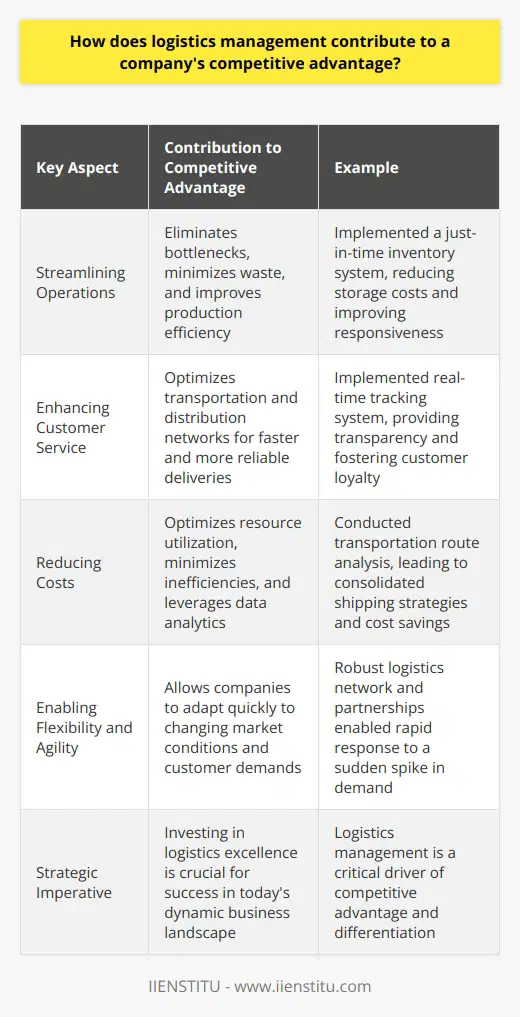
What are the key components of logistics management?
Logistics management is a critical component of supply chain operations. It involves planning, implementing, and controlling the flow of goods, services, and information from the point of origin to the point of consumption. Here are the key components of logistics management:
Transportation
I've worked in logistics for over a decade, and I can tell you that transportation is the backbone of logistics management. It involves selecting the most efficient and cost-effective modes of transportation, such as air, sea, rail, or road, to move goods from one location to another. Effective transportation management requires careful planning, route optimization, and carrier selection to ensure timely delivery and minimize costs.
Warehousing
Warehousing is another crucial aspect of logistics management. It involves storing and managing inventory in a warehouse or distribution center. Effective warehousing requires efficient space utilization, inventory control, and order fulfillment processes. In my experience, implementing a warehouse management system (WMS) can significantly improve inventory accuracy and reduce order processing time.
Inventory Management
Inventory management is all about balancing supply and demand. It involves determining the optimal inventory levels to meet customer demand while minimizing carrying costs. Effective inventory management requires accurate forecasting, demand planning, and replenishment strategies. I've seen companies struggle with excess inventory or stockouts due to poor inventory management practices.
Packaging and Material Handling
Packaging and material handling are often overlooked but essential components of logistics management. Proper packaging ensures that goods are protected during transportation and storage. Material handling involves the movement of goods within a warehouse or distribution center, including receiving, putaway, picking, and shipping. Efficient material handling processes can reduce labor costs and improve order accuracy.
Information Technology
Information technology plays a vital role in logistics management. It enables real-time visibility, tracking, and communication throughout the supply chain. Logistics management systems, such as transportation management systems (TMS) and warehouse management systems (WMS), automate processes and provide valuable data for decision-making. In my opinion, investing in the right technology solutions can give companies a competitive edge in today's fast-paced business environment.
In conclusion, logistics management is a complex and multifaceted discipline that requires a deep understanding of transportation, warehousing, inventory management, packaging and material handling, and information technology. By optimizing these key components, companies can improve their supply chain efficiency, reduce costs, and enhance customer satisfaction.
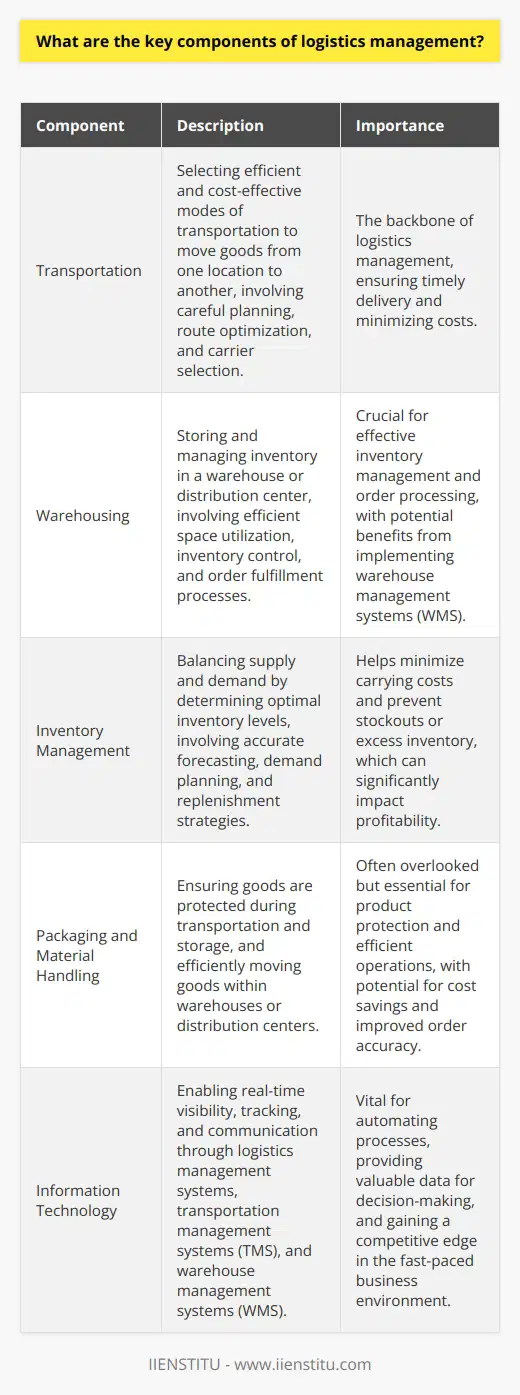
How do you measure the effectiveness of a logistics management system?
When measuring the effectiveness of a logistics management system, I consider several key factors. First and foremost, I look at how well the system optimizes inventory levels and reduces carrying costs. This involves striking a delicate balance between having enough stock to meet customer demand while minimizing excess inventory that ties up capital and warehouse space.
Streamlining Operations
Another critical aspect is how efficiently the logistics system streamlines operations. I assess how well it coordinates the flow of goods from suppliers to warehouses to customers. The goal is to minimize lead times, reduce handling, and optimize transportation routes to save time and money.
Tracking Key Metrics
To gauge effectiveness, I track key performance indicators like order accuracy, on-time delivery rates, and customer satisfaction scores. These metrics provide valuable insights into how well the logistics system is functioning and where improvements can be made.
Leveraging Technology
I also evaluate how effectively the logistics management system leverages technology. Automated systems, real-time tracking, and data analytics can significantly enhance visibility, decision-making, and overall performance. The best logistics solutions seamlessly integrate these technologies to drive efficiency and optimize resources.
Continuous Improvement
Finally, I believe that a truly effective logistics management system is one that embraces continuous improvement. It should be adaptable, scalable, and constantly evolving to meet changing business needs and market conditions. By regularly reviewing processes, identifying bottlenecks, and implementing enhancements, a logistics system can stay ahead of the curve and deliver lasting value.
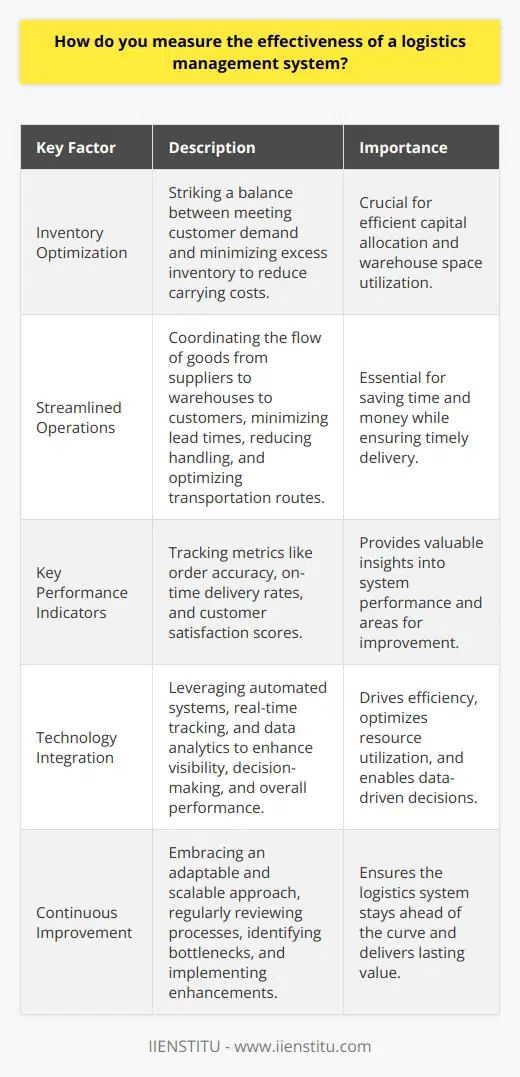
What are the main challenges faced in logistics management?
As a logistics manager, I've faced numerous challenges throughout my career. One of the primary challenges is managing inventory effectively.
Inventory Management
It's crucial to strike a balance between having enough stock to meet customer demand and avoiding excess inventory. I've learned that implementing a robust inventory management system is key to overcoming this challenge.
Effective Communication
Another significant challenge is ensuring smooth communication and coordination among various stakeholders, such as suppliers, transporters, and warehouses. I've found that regular meetings and using collaborative tools help streamline communication and minimize misunderstandings.
Adapting to Technology
Keeping up with the latest technology trends is essential in logistics management. I've had to constantly educate myself and my team about new software and automation solutions that can improve our processes.
Managing Costs
Cost management is an ongoing challenge in logistics. I've had to negotiate with vendors, optimize routes, and find innovative ways to reduce expenses without compromising quality.
Despite these challenges, I find logistics management to be a rewarding and dynamic field. It requires creative problem-solving, adaptability, and a willingness to learn continuously. I believe that my experience in tackling these challenges has prepared me well for this role in your organization.

How do you ensure timely delivery of goods in logistics management?
To ensure timely delivery of goods in logistics management, I rely on several key strategies. First and foremost, I maintain open lines of communication with all stakeholders involved in the supply chain. This includes suppliers, carriers, and customers. By keeping everyone informed and up-to-date, we can quickly address any potential delays or issues that may arise.
Proactive Planning and Risk Management
I believe in proactive planning and risk management. I always have contingency plans in place for potential disruptions, such as weather events or transportation breakdowns. By anticipating and preparing for these challenges, we can minimize their impact on delivery timelines.
Leveraging Technology
Technology plays a crucial role in streamlining logistics processes. I leverage tools like real-time tracking systems, automated inventory management, and data analytics to optimize routes, monitor shipments, and ensure efficient resource allocation. These technologies help us stay on top of our deliveries and make informed decisions.
Building Strong Partnerships
Building strong partnerships with reliable carriers and suppliers is essential. I carefully select partners who share our commitment to timely delivery and have a proven track record of reliability. By fostering these relationships, we can count on their support and expertise to keep our supply chain running smoothly.
Continuous Improvement
Finally, I believe in continuous improvement. I regularly review our processes, identify areas for optimization, and implement changes to enhance efficiency. By constantly seeking ways to streamline our operations, we can ensure that our logistics management remains agile and responsive to changing demands.
In my experience, combining these strategies has allowed me to consistently meet delivery deadlines and exceed customer expectations. I'm confident that my approach to logistics management will enable me to drive success in this role.

What strategies can be used to optimize logistics costs?
As a logistics manager, I've found several effective strategies for optimizing costs while maintaining quality service.
Streamline processes
I always look for ways to simplify and automate workflows. This reduces errors and boosts efficiency, lowering overall expenses.
Negotiate with vendors
Building strong relationships with suppliers is key. I meet regularly to discuss pricing, terms, and potential discounts for bulk orders.
Optimize transportation
Choosing the right carriers and routes makes a big difference. I compare options to find the best combination of speed and cost. Consolidating shipments helps too.
Manage inventory carefully
Avoiding stockouts and overstocking is a delicate balance. I use demand forecasting models to predict needs and set appropriate stock levels.
Invest in technology
The right software tools provide visibility and control. I've implemented warehouse and transportation management systems with great ROI.
In my experience, continuously monitoring and adjusting these areas leads to major savings over time. It takes effort and collaboration, but it's very rewarding to run an efficient, cost-effective operation.
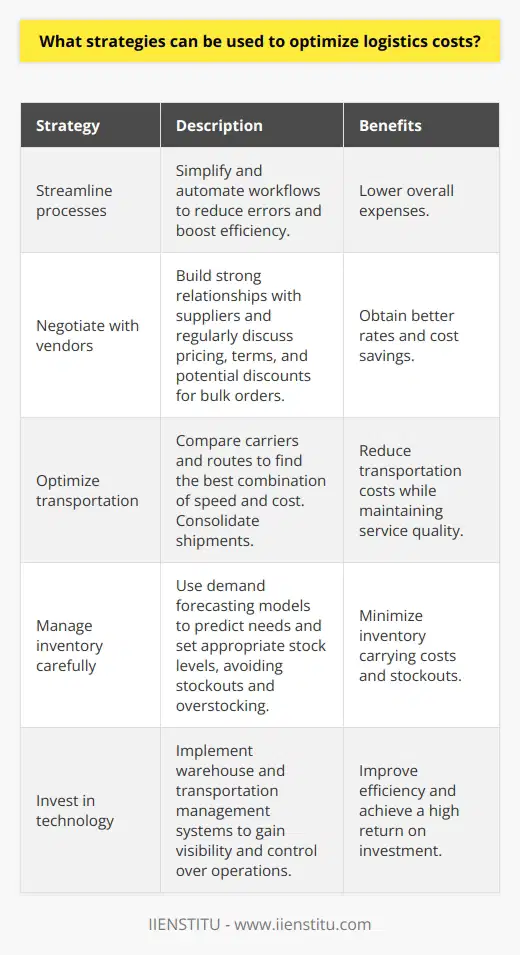
How do you manage inventory levels in a logistics system?
When it comes to managing inventory levels in a logistics system, I always start by analyzing historical data. This helps me identify patterns and trends in demand, so I can make informed decisions. I also collaborate closely with sales and marketing teams to get a sense of upcoming promotions or product launches that could impact inventory needs.
Balancing Safety Stock and Efficiency
One key strategy I use is maintaining a balanced level of safety stock. You want enough buffer to avoid stockouts, but not so much that you're tying up excessive capital. I find that regular communication with suppliers is crucial for staying on top of lead times and adjusting safety stock accordingly.
Leveraging Technology for Real-Time Visibility
I'm a big believer in using technology to streamline inventory management. Tools like real-time tracking and automated alerts help me stay on top of stock levels and quickly identify potential issues. I've also had success with implementing barcode scanning systems to improve accuracy and efficiency during receiving and picking processes.
Continuous Improvement Through Data Analysis
Finally, I think it's important to continuously monitor and analyze inventory data. I regularly review key metrics like inventory turnover and carrying costs to identify areas for improvement. By staying proactive and data-driven, I've been able to optimize inventory levels and drive significant cost savings in past roles.
At the end of the day, effective inventory management is all about finding that sweet spot between customer service and operational efficiency. It requires a combination of strategic planning, real-time monitoring, and a willingness to continuously improve. That's the approach I strive to bring to any logistics role.
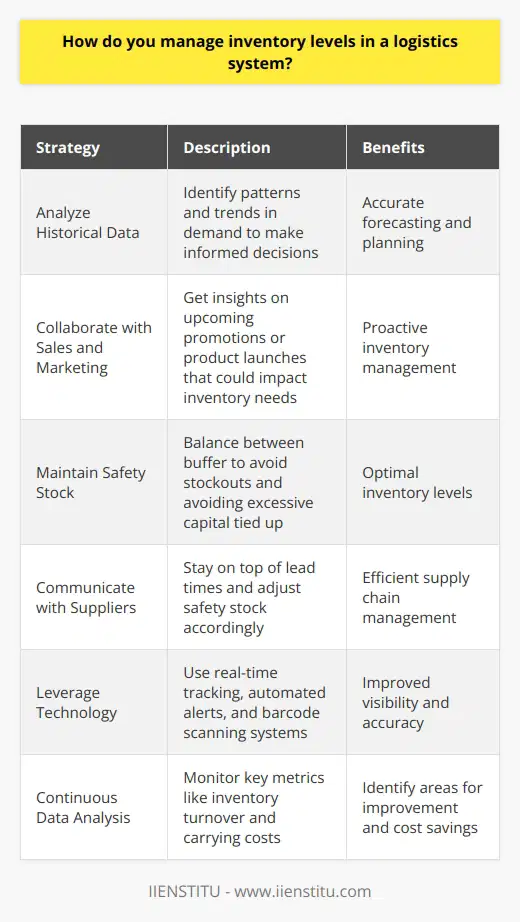
What is the importance of transportation in logistics management?
Transportation plays a crucial role in logistics management. It ensures that goods are moved efficiently from suppliers to customers. Proper transportation management helps companies reduce costs, improve delivery times, and enhance customer satisfaction.
Key Benefits of Effective Transportation in Logistics
I've seen firsthand how optimizing transportation can transform a business. By carefully planning routes and choosing the right carriers, companies can cut shipping expenses without sacrificing quality. This frees up resources that can be invested in other areas, like product development or marketing.
Transportation also directly impacts customer experience. When I order something online, I expect it to arrive quickly and in perfect condition. Brands that consistently meet those expectations earn my loyalty and recommendations. On the flip side, I've stopped shopping with companies after repeated shipping delays or damaged packages.
Choosing the Right Transportation Strategies
There's no one-size-fits-all approach to transportation management. The best strategies depend on factors like the type of products being shipped, delivery locations, and customer requirements. For example, a company sending perishable goods may prioritize speed over cost, while another may opt for eco-friendly shipping methods to appeal to green-conscious consumers.
In my experience, the most successful logistics professionals are those who stay flexible and continuously adapt their transportation plans based on data and feedback. They invest in technology to optimize routes, track shipments, and communicate with carriers and customers. Above all, they never lose sight of the end goal: getting the right products to the right places at the right times.

How do you select and manage logistics service providers?
When selecting logistics service providers, I prioritize companies with a proven track record of reliability and efficiency. I carefully evaluate their capabilities, such as their transportation network, warehousing facilities, and technology systems. It's crucial to choose providers that align with our specific business requirements and can scale alongside our growth.
Key Factors in Provider Selection
I look for logistics partners who demonstrate financial stability and have a solid reputation in the industry. Competitive pricing is important, but I also value providers who offer value-added services and innovative solutions. Flexibility and adaptability are essential qualities, as our logistics needs may evolve over time.
Effective Communication and Collaboration
Once I've selected the right logistics providers, I focus on building strong relationships based on open communication and trust. I establish clear performance metrics and service level agreements to ensure accountability. Regular meetings and performance reviews help identify areas for improvement and foster continuous optimization of our logistics operations.
Leveraging Technology for Visibility and Efficiency
I work closely with our logistics partners to implement advanced technology solutions that enhance visibility and streamline processes. Real-time tracking, automated data exchange, and cloud-based collaboration platforms are essential for effective supply chain management. By embracing digital tools, we can make data-driven decisions and respond quickly to changing market dynamics.
Continuous Improvement and Adaptability
Managing logistics service providers is an ongoing process that requires continuous improvement and adaptability. I encourage a culture of innovation and seek out providers who are proactive in identifying opportunities for optimization. By staying agile and embracing change, we can navigate the complex challenges of the modern logistics landscape and drive long-term success.

What are the latest trends and technologies in logistics management?
As someone who closely follows the logistics industry, I've noticed several exciting trends and technologies emerging lately. One major development is the increased adoption of automation and robotics in warehouses and distribution centers. Companies are investing in autonomous mobile robots, conveyor systems, and picking robots to streamline operations and boost efficiency.
Another trend I've observed is the growing use of artificial intelligence and machine learning in logistics management. AI-powered systems can analyze vast amounts of data to optimize routes, predict demand, and improve decision-making. This helps companies reduce costs, enhance customer service, and stay agile in a rapidly changing market.
Real-time visibility is transforming logistics
I'm also excited about the advancements in real-time visibility technologies like GPS tracking, IoT sensors, and blockchain. These tools provide end-to-end transparency across the supply chain, allowing companies to monitor shipments, identify bottlenecks, and respond quickly to disruptions. Real-time visibility is a game-changer for improving collaboration, mitigating risks, and meeting customer expectations.
Sustainability is driving innovation
Lastly, I've noticed a strong focus on sustainability and green logistics practices. Companies are exploring alternative fuel vehicles, optimizing packaging to reduce waste, and implementing circular economy principles. It's inspiring to see the industry taking steps to minimize its environmental impact and promote long-term sustainability.
Overall, I believe these trends and technologies are reshaping the future of logistics management. By embracing innovation, companies can gain a competitive edge, improve operational excellence, and deliver value to their customers. It's an exciting time to be part of this dynamic and ever-evolving field.
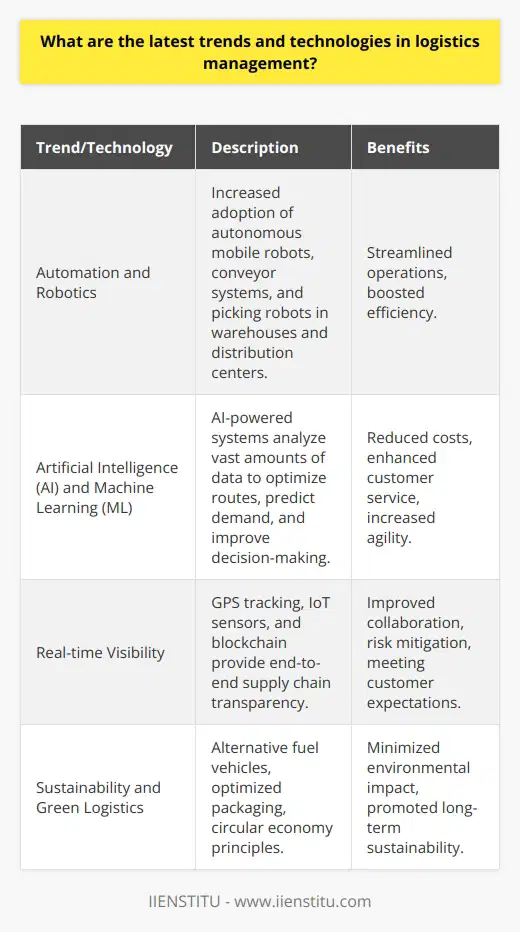
How do you handle reverse logistics and product returns?
When it comes to handling reverse logistics and product returns, I have a well-defined process in place. I start by carefully inspecting the returned item to determine the reason for the return. This helps me categorize the product and decide on the appropriate action.
Efficient Communication
I promptly communicate with the customer to acknowledge the return and provide them with an estimated timeline. Keeping the customer informed throughout the process is crucial for maintaining their trust and satisfaction.
Streamlined Workflow
I have established a streamlined workflow that ensures efficient processing of returns. This includes properly documenting the return, updating inventory records, and coordinating with the relevant departments for further action.
Resale or Refurbishment
If the returned product is in good condition, I assess the possibility of reselling it or refurbishing it. This helps minimize waste and recover some of the costs associated with the return.
Disposal or Recycling
For products that cannot be resold or refurbished, I follow proper disposal or recycling procedures. I ensure compliance with environmental regulations and strive to minimize the ecological impact of the returned items.
Continuous Improvement
I believe in continuously improving the reverse logistics process. I analyze return data to identify patterns and trends. This information helps me make recommendations for product improvements and process optimization.
Throughout my experience, I have successfully handled numerous product returns and have consistently maintained a high level of customer satisfaction. I am confident in my ability to efficiently manage reverse logistics and contribute to the company's success in this area.
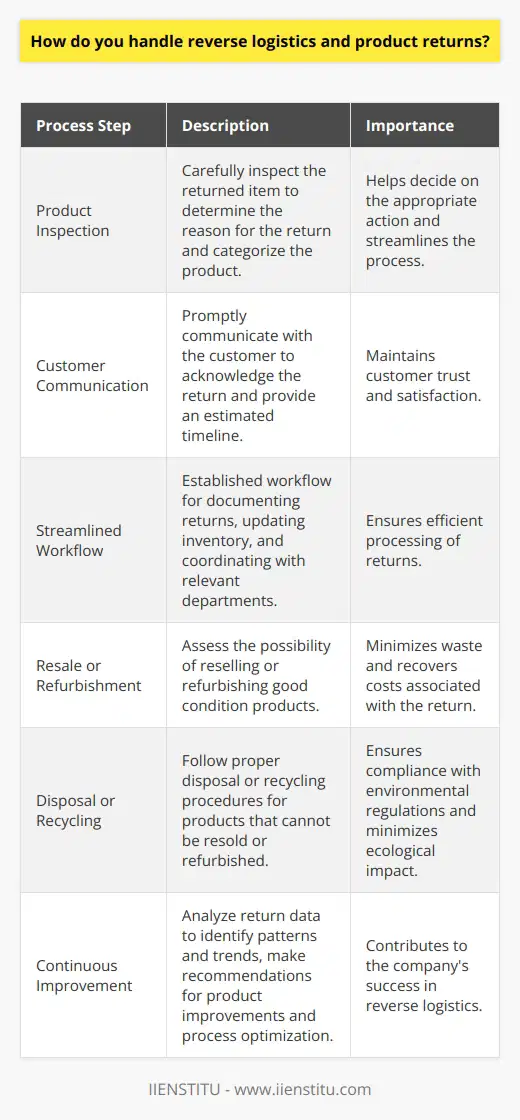
What are the environmental considerations in logistics management?
Reducing Environmental Impact in Logistics
When it comes to environmental considerations in logistics management, I believe we have a responsibility to minimize our impact. I've always been passionate about sustainability, and I try to bring that mindset to my work. There are several key areas where we can make a difference.
Optimizing Routes and Load Capacity
One of the most effective ways to reduce emissions is by optimizing transportation routes and maximizing load capacity. By carefully planning our shipments and consolidating loads, we can decrease the number of trips needed. Fewer miles driven translates directly to lower fuel consumption and reduced carbon output.
Choosing Eco-Friendly Packaging
Another important consideration is packaging. Whenever possible, we should opt for recycled, recyclable, and biodegradable materials. I remember a project at my previous job where we switched to 100% recycled shipping boxes. Not only did it shrink our environmental footprint, but it also resonated with our customers who appreciated the eco-friendly choice.
Partnering with Green Vendors
It's also crucial to partner with vendors and carriers who share our commitment to sustainability. By working with companies that invest in fuel-efficient vehicles, alternative energy, and green initiatives, we can amplify our positive impact. I believe in building strong relationships with like-minded partners to drive environmental progress in the logistics industry.
Continuous Improvement
Ultimately, being environmentally responsible in logistics management is an ongoing journey. We must continuously evaluate our processes, embrace new technologies, and strive to do better. It's not always easy, but it's incredibly rewarding to know that our efforts can make a real difference for the planet.
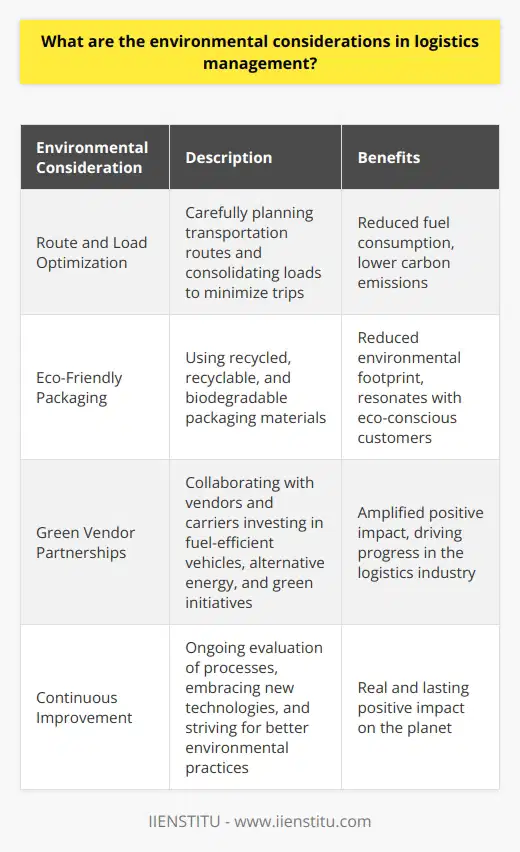
How do you manage risk in logistics operations?
When it comes to managing risk in logistics operations, I believe in taking a proactive and systematic approach. Throughout my career, I've learned that effective risk management is crucial for ensuring smooth and efficient supply chain processes.
Identifying Potential Risks
The first step is to thoroughly analyze the entire logistics operation and identify potential risks. This includes assessing factors such as transportation routes, supplier reliability, weather conditions, and market fluctuations. By anticipating and understanding these risks, we can develop appropriate mitigation strategies.
Developing Contingency Plans
Once the risks are identified, I work closely with my team to develop comprehensive contingency plans. These plans outline specific actions to be taken in case of disruptions or emergencies. For example, when I was working at my previous company, we established alternative transportation routes and backup suppliers to ensure continuous operations in case of unforeseen events.
Implementing Risk Monitoring Systems
To effectively manage risks, it's essential to have robust monitoring systems in place. I've implemented various tools and technologies to track key performance indicators and detect any deviations from normal operations. This allows us to quickly identify and address potential issues before they escalate into major problems.
Collaborating with Stakeholders
Risk management in logistics is a collaborative effort. I actively engage with stakeholders, including suppliers, carriers, and customers, to align our risk management strategies. Regular communication and information sharing help us stay informed about potential risks and coordinate our response efforts.
Continuous Improvement
Managing risk is an ongoing process. I believe in continuously evaluating and improving our risk management practices. By conducting regular audits, analyzing performance data, and seeking feedback from team members, we can identify areas for improvement and implement necessary changes.
In my experience, effective risk management in logistics requires a combination of proactive planning, real-time monitoring, and collaborative problem-solving. By staying vigilant and adaptable, we can minimize the impact of risks and ensure the smooth flow of goods throughout the supply chain.

What is the role of warehousing in logistics management?
Warehousing plays a crucial role in logistics management. It involves the storage and handling of goods before distribution. Efficient warehousing ensures that products are available when needed, reducing lead times and improving customer satisfaction.
Inventory Management
Warehouses help businesses manage their inventory levels effectively. They provide a centralized location to store goods until they're ready for shipment. By keeping track of stock levels, companies can avoid stockouts and overstocking, which can be costly.
Examples from my experience:
Order Fulfillment
Warehouses are critical for order fulfillment. They receive orders, pick the required products, pack them, and prepare them for shipping. An organized warehouse layout and efficient processes can significantly speed up order fulfillment times.
Personal thoughts:
I believe that automation and technology are transforming warehousing operations. Robotics, conveyor systems, and software are making order fulfillment faster and more accurate than ever before. It's exciting to see how these advancements are reshaping the industry.
Risk Mitigation
Warehouses help mitigate various risks in logistics management. They protect goods from damage, theft, and weather conditions. Proper storage and handling techniques ensure that products remain in good condition until they reach the customer.
In conclusion, warehousing is an essential component of logistics management. It enables efficient inventory management, order fulfillment, and risk mitigation. As someone passionate about logistics, I find the world of warehousing fascinating and constantly evolving.
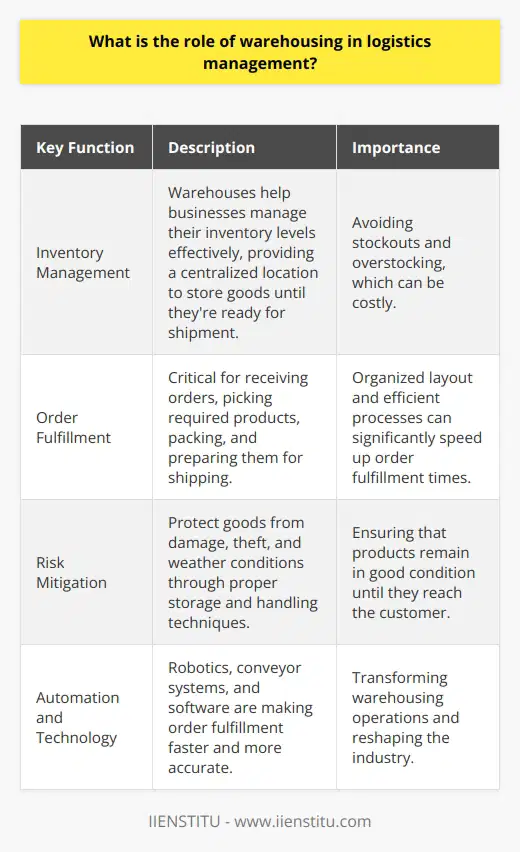
How do you optimize warehouse layout and operations?
When optimizing warehouse layout and operations, I focus on a few key areas. First, I analyze the current layout and identify any bottlenecks or inefficiencies. This might involve conducting time studies or reviewing data on product flow through the warehouse.
Streamlining Product Flow
Based on this analysis, I develop a plan to streamline product flow. This could include rearranging storage racks, modifying picking routes, or implementing new technology like conveyor systems or automated storage and retrieval.
I remember one project where we completely reconfigured a client's warehouse layout. By moving high-volume items closer to the shipping area and optimizing pick paths, we reduced travel time by over 30%. The pickers were thrilled because it made their jobs so much easier.
Inventory Management
Effective inventory management is also crucial. I work with the team to identify slow-moving or obsolete stock and develop strategies to clear it out. We also review reorder points and safety stock levels regularly to prevent stockouts.
In my experience, cycle counting is a great way to maintain inventory accuracy without shutting down operations for a full physical count. I train warehouse staff on proper cycle counting techniques and develop a schedule to count a few items each day.
Continuous Improvement
Finally, I believe in continuous improvement. I encourage workers to share their ideas and we have regular brainstorming sessions. Small changes can add up to big efficiency gains over time.
Optimizing warehouse layout and operations is complex, but also very rewarding. I love the challenge of finding ways to work smarter, not harder. Let me know if you have any other questions! I could talk about this stuff all day.
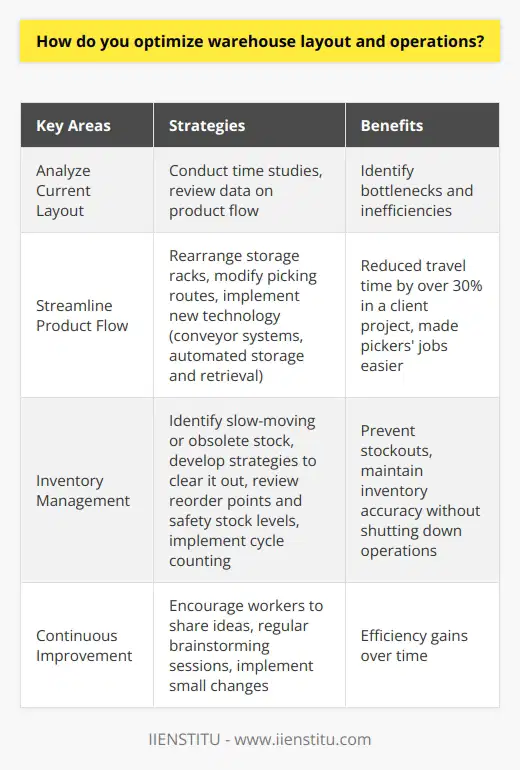
What are the key performance indicators (KPIs) used in logistics management?
As a logistics professional, I understand the importance of measuring performance through key performance indicators (KPIs). These metrics help us track progress, identify areas for improvement, and ensure we're meeting our goals.
On-Time Delivery
One of the most critical KPIs in logistics is on-time delivery. It measures the percentage of shipments delivered on schedule. This KPI directly impacts customer satisfaction and loyalty. In my experience, consistently achieving high on-time delivery rates requires strong coordination and communication across the supply chain.
Inventory Accuracy
Another important KPI is inventory accuracy. It compares the actual inventory levels to what's recorded in the system. Maintaining accurate inventory data is essential for making informed decisions and avoiding stockouts or overstocking. I've found that regular cycle counting and root cause analysis can help improve inventory accuracy.
Transportation Costs
Monitoring transportation costs is crucial for controlling expenses and optimizing routes. This KPI tracks the cost per mile, per shipment, or as a percentage of sales. By analyzing transportation data, we can identify opportunities to reduce costs through carrier negotiations, load consolidation, or modal shifts.
Warehouse Efficiency
Measuring warehouse efficiency helps assess productivity and resource utilization. Common metrics include order pick rate, order accuracy, and space utilization. Implementing lean principles and continuous improvement initiatives can drive significant gains in warehouse performance.
Customer Satisfaction
Ultimately, the success of logistics operations depends on customer satisfaction. Tracking customer feedback, complaint resolution time, and repeat business provides valuable insights into service quality. In my role, I strive to proactively address customer concerns and continuously enhance the customer experience.
By monitoring these KPIs and taking a data-driven approach to decision-making, logistics managers can optimize operations and deliver exceptional service to customers.

How do you ensure the security of goods during transportation?
As a logistics professional, I understand the critical importance of ensuring the security of goods during transportation. Here are some key strategies I employ to maintain the integrity and safety of shipments:
Rigorous Screening of Personnel
I personally oversee the hiring process for all team members involved in handling goods. Background checks, references, and thorough interviews are essential. I look for individuals with a proven track record of reliability and honesty.
Implementing Strict Protocols
Clear, detailed procedures are the backbone of secure transportation. I work closely with my team to develop and enforce protocols for every stage of the shipping process. From loading and unloading to route planning and delivery confirmation, each step has its own checklist and verification process.
Leveraging Technology
In my experience, technology is a powerful ally in the fight against cargo theft and tampering. I advocate for the use of GPS tracking, RFID tags, and remote monitoring systems. These tools allow real-time visibility and quick response to any potential issues.
Building Strong Partnerships
I believe in fostering relationships with trusted carriers, warehouses, and other logistics partners. By working with reputable companies that share our commitment to security, we create a network of accountability and mutual support.
Continuous Training and Improvement
Security threats are always evolving, so our strategies must evolve too. I make it a priority to stay informed about the latest industry best practices and emerging technologies. Regular training sessions keep our team sharp and adaptable.
At the end of the day, ensuring the security of goods is about staying vigilant, proactive, and committed to excellence. It's a responsibility I take seriously, and I'm confident in my ability to deliver results.
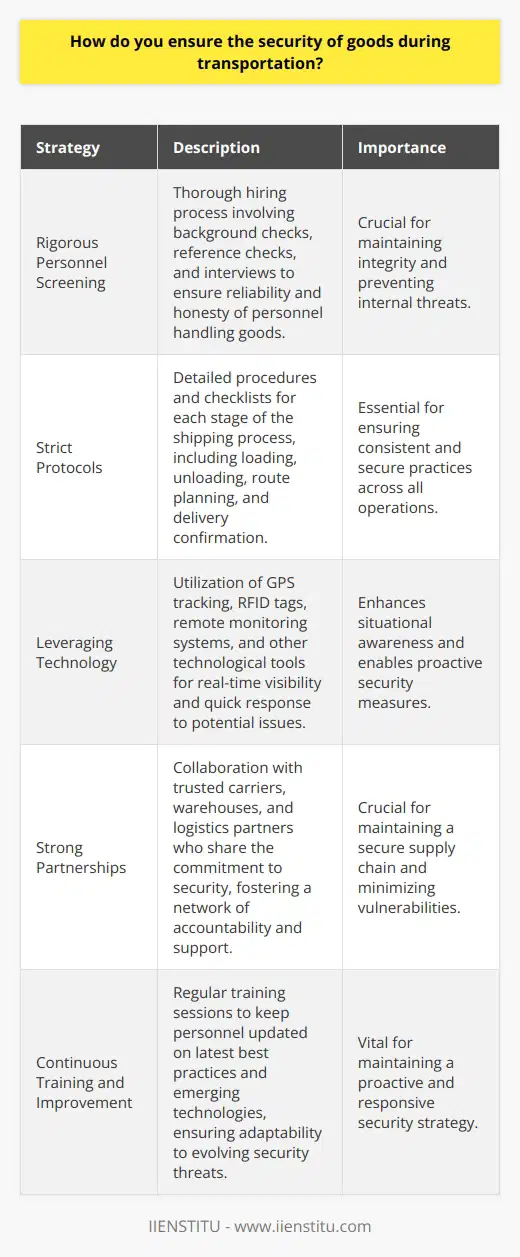
What is the importance of packaging in logistics management?
Packaging plays a crucial role in logistics management, ensuring products reach customers safely and efficiently. It protects goods from damage during transit, reducing waste and customer dissatisfaction. Proper packaging also optimizes space utilization in warehouses and transportation vehicles.
Protection and Preservation
I once received a fragile gift that arrived shattered due to inadequate packaging. This experience highlighted the importance of robust packaging in safeguarding products throughout the supply chain. Appropriate packaging materials and techniques minimize damage risks, maintaining product quality and integrity.
Efficient Space Utilization
Well-designed packaging maximizes space efficiency in storage and transportation. I've seen how compact, stackable packages enable higher inventory density and reduce transportation costs. This optimization is essential for streamlining logistics operations and improving overall supply chain performance.
Branding and Information
Packaging serves as a powerful branding tool, creating a positive first impression on customers. It communicates essential product information, including handling instructions and regulatory compliance. Clear labeling and attractive packaging design enhance customer experience and brand recognition.
Environmental Sustainability
In my opinion, sustainable packaging is becoming increasingly important in logistics management. Eco-friendly materials and recyclable packaging options reduce environmental impact and appeal to environmentally conscious consumers. Adopting sustainable packaging practices demonstrates a company's commitment to corporate social responsibility.
In conclusion, packaging is a vital component of effective logistics management. It ensures product protection, optimizes space utilization, enhances branding, and promotes sustainability. By investing in high-quality packaging solutions, companies can improve customer satisfaction, reduce costs, and strengthen their competitive advantage in the market.

How do you manage cross-border logistics and customs clearance?
At my previous company, I managed cross-border logistics and customs clearance for international shipments. This involved coordinating with multiple parties, including suppliers, carriers, and customs brokers.
Understanding Regulations
I stayed up-to-date on the latest customs regulations and trade agreements for each country we shipped to. This allowed me to ensure compliance and avoid delays or penalties.
Example: Navigating Brexit Changes
When Brexit took effect, I quickly researched the new requirements for shipping between the UK and EU. I collaborated with our customs broker to update our documentation and processes.
Streamlining Documentation
Accurate and complete paperwork is critical for smooth customs clearance. I implemented systems to streamline document preparation and submission.
Automation Tools
We adopted software that automatically populated customs forms based on shipment data. This saved time and reduced errors compared to manual entry.
Building Strong Partnerships
I developed close working relationships with our carriers and customs brokers. Frequent communication helped us stay aligned and quickly resolve any issues that arose.
Preventing Delays
If a shipment was at risk of being held up in customs, I proactively reached out to our broker. Together we'd identify the problem and find a solution to get things moving again.
In summary, effective cross-border logistics requires understanding regulations, efficient documentation, and strong partner relationships. I believe my skills and experience in this area would be an asset to your company.
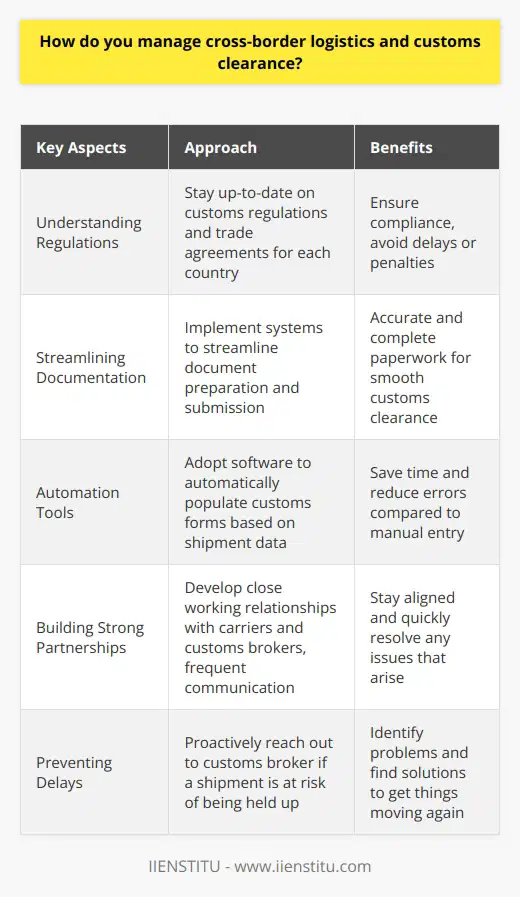
What are the best practices in logistics network design?
When designing a logistics network, there are several best practices to keep in mind. First and foremost, it's crucial to have a clear understanding of your company's supply chain goals and requirements.
Analyze Your Current Network
Take a close look at your existing logistics network. Identify areas that are working well and those that need improvement. This analysis will help guide your design decisions.
Consider Your Customers
Your logistics network should be designed with your customers in mind. Think about their locations, delivery expectations, and any special requirements they may have. Aim to create a network that can efficiently serve their needs.
Embrace Technology
In today's fast-paced business environment, technology is essential. Invest in systems that can streamline your operations, provide real-time visibility, and help you make data-driven decisions. Automation can also play a key role in improving efficiency.
Build Flexibility into Your Network
The business landscape is constantly changing, so your logistics network needs to be adaptable. Design your network with flexibility in mind, so you can quickly respond to shifts in demand or unexpected disruptions.
Collaborate with Partners
Building strong relationships with your logistics partners is essential. Work closely with carriers, warehouses, and other service providers to ensure seamless operations. Open communication and collaboration can lead to better performance and more innovative solutions.
By following these best practices, you can create a logistics network that is efficient, responsive, and focused on delivering value to your customers.
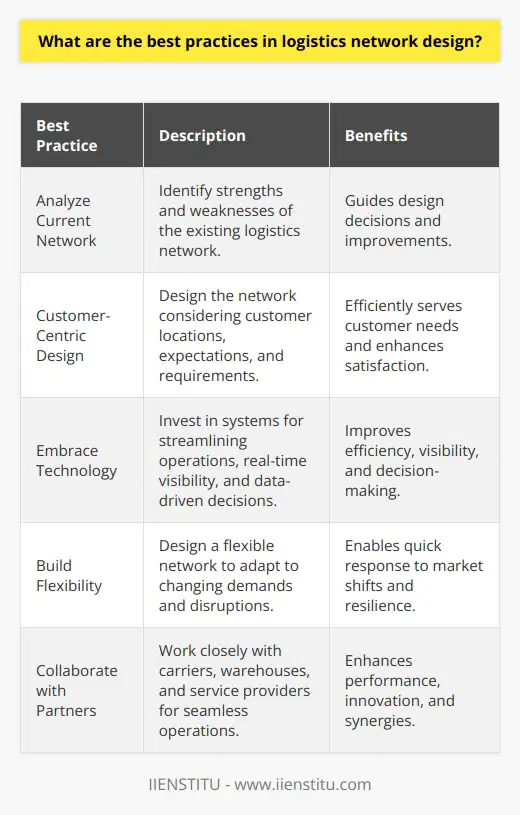
How do you handle perishable or time-sensitive goods in logistics?
When handling perishable or time-sensitive goods in logistics, I follow a strict set of protocols. First and foremost, I ensure that the storage environment is optimal for the specific product. This includes maintaining the correct temperature, humidity, and ventilation levels. I also pay close attention to expiration dates and use a first-in, first-out (FIFO) inventory system.
Efficient Tracking and Monitoring
To minimize spoilage and waste, I implement an efficient tracking and monitoring system. This involves using technology such as RFID tags and sensors to monitor the condition of the goods in real-time. If any issues are detected, I take immediate action to rectify the situation. I also conduct regular inspections to ensure that the products are in good condition.
Collaboration with Stakeholders
Effective communication and collaboration with stakeholders are crucial when dealing with perishable goods. I work closely with suppliers, transportation partners, and customers to ensure that everyone is on the same page. This includes providing clear instructions on handling requirements and coordinating delivery schedules to minimize transit times.
Contingency Planning
Despite best efforts, unexpected issues can arise when handling perishable goods. That's why I always have contingency plans in place. This includes identifying alternative storage facilities, transportation routes, and suppliers in case of emergencies. By being proactive and prepared, I can minimize disruptions and ensure that the products reach their destination in optimal condition.
In summary, handling perishable goods requires a combination of technical expertise, attention to detail, and effective communication. By following best practices and staying vigilant, I ensure that the products in my care remain fresh and of the highest quality.
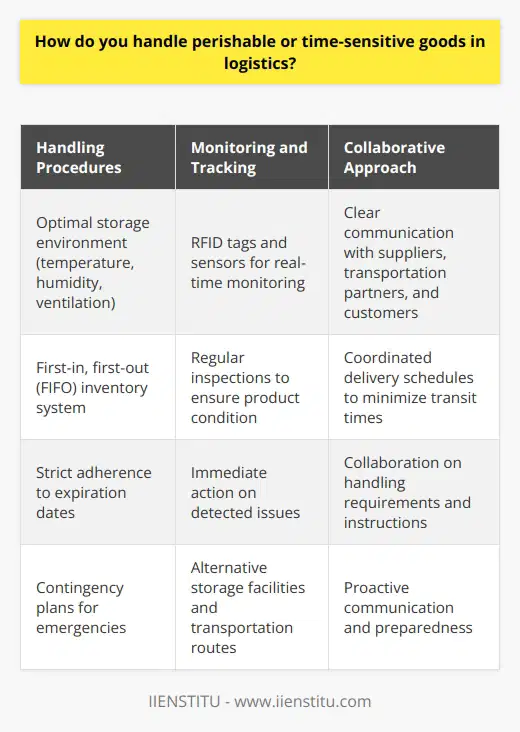
What is the role of technology in modern logistics management?
Technology plays a crucial role in modern logistics management. It enables real-time tracking, automation, and optimization of supply chains. By leveraging technologies such as RFID, GPS, and cloud computing, businesses can gain end-to-end visibility into their operations.
Enhancing Efficiency and Productivity
I've seen firsthand how technology streamlines processes and boosts productivity in logistics. In my previous role, we implemented a warehouse management system that automated inventory tracking and order fulfillment. It reduced manual errors and significantly improved our order accuracy and turnaround times.
Data-Driven Decision Making
Technology enables data-driven decision making in logistics. By analyzing real-time data from various touchpoints, managers can identify bottlenecks, optimize routes, and make informed decisions. I find it fascinating how predictive analytics can even anticipate demand and help plan resources accordingly.
Enabling Collaboration and Integration
Modern logistics heavily relies on collaboration and integration between stakeholders. Technology facilitates seamless information sharing and communication across the supply chain. I remember how implementing a cloud-based platform transformed our collaboration with suppliers and carriers, leading to better coordination and faster issue resolution.
Enhancing Customer Experience
In my opinion, technology is key to enhancing customer experience in logistics. With real-time tracking and notifications, customers can stay informed about their shipments. Additionally, technology enables personalized and flexible delivery options, meeting the evolving expectations of today's consumers.
In conclusion, technology is indispensable in modern logistics management. It drives efficiency, enables data-driven decisions, facilitates collaboration, and enhances customer satisfaction. As someone passionate about logistics, I'm excited to leverage technology to optimize operations and deliver exceptional results.
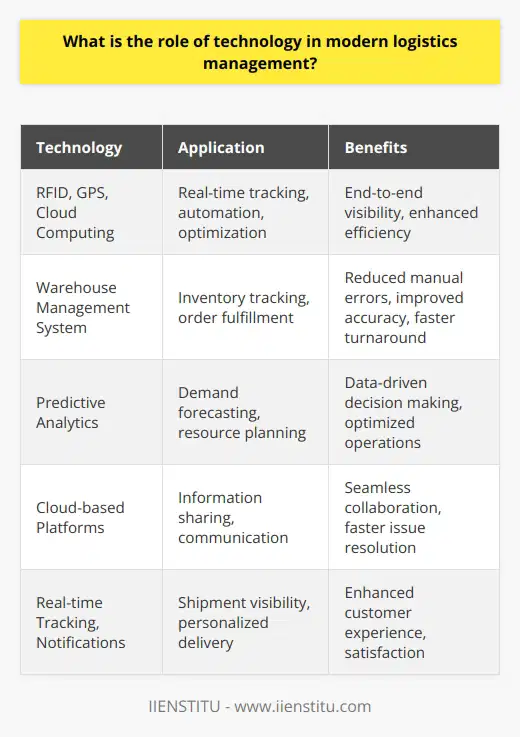
How do you manage logistics in an e-commerce environment?
When it comes to managing logistics in an e-commerce environment, I believe in taking a proactive and organized approach. Here are some strategies I've found effective:
Streamline Inventory Management
I make sure to carefully track inventory levels and set reorder points to avoid stockouts. This helps keep popular items in stock while preventing excess inventory that ties up capital.
Foster Strong Supplier Relationships
Building positive, communicative relationships with suppliers is key. I reach out regularly to ensure we're on the same page about lead times, product specs, and potential issues.
Optimize Warehouse Operations
An efficient warehouse is critical. I analyze picking routes, storage locations, and packing processes to cut down on wasted time and effort. Small tweaks can really boost productivity.
Leverage Technology Solutions
The right software tools make all the difference. I'm a big fan of inventory management systems, real-time order tracking, and data analytics to identify bottlenecks and improvement opportunities.
Plan for Contingencies
Even the best-laid plans can hit snags, so I always have backup plans ready. Whether it's lining up alternate suppliers or padding lead times for high-demand periods, I try to anticipate potential problems before they happen.
At the end of the day, successfully managing e-commerce logistics is all about staying organized, communicating clearly, and continuously looking for ways to optimize. It's challenging but also really rewarding when everything comes together smoothly!
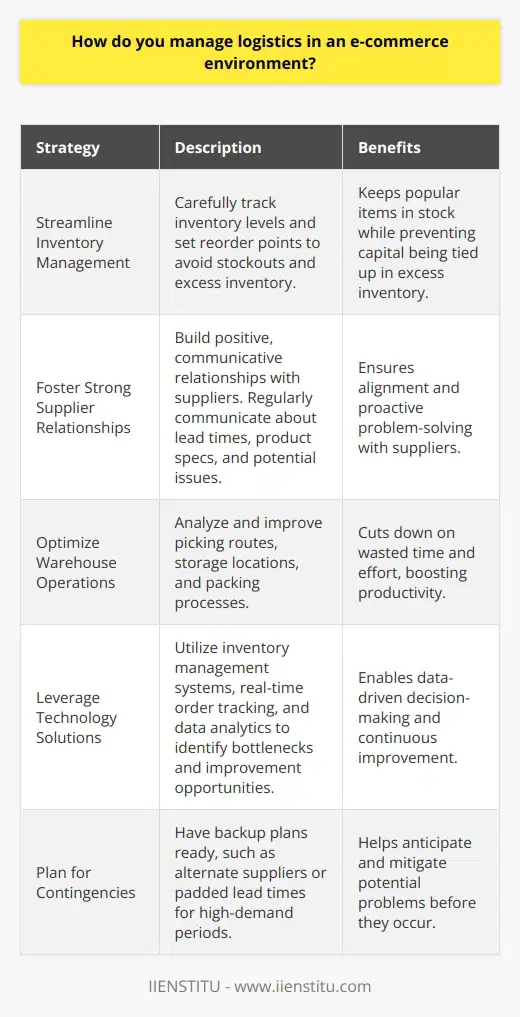
What are the strategies for reducing lead times in logistics?
As a logistics professional with over a decade of experience, I've found several effective strategies for reducing lead times:
Streamline processes
Take a close look at your current processes and identify areas for improvement. Eliminate unnecessary steps and automate where possible. This can significantly speed up operations and reduce lead times.
Foster strong supplier relationships
Collaborate closely with suppliers to ensure timely deliveries. Share forecasts, set clear expectations, and maintain open lines of communication. Strong partnerships are key to compressing timelines.
Optimize inventory management
Implement a robust inventory management system to avoid stockouts and overstocking. Use data analytics to predict demand and adjust stock levels accordingly. Well-managed inventory minimizes delays.
Leverage technology solutions
Invest in logistics technologies like transportation management systems and warehouse management systems. These tools provide real-time visibility, enabling quicker decision-making and shorter lead times.
Continuously measure and improve
Regularly monitor key performance indicators related to lead times. Analyze this data to pinpoint bottlenecks and improvement opportunities. Continuous measurement and refinement are essential for maintaining efficiency.
In my experience, a multifaceted approach that combines process optimization, collaboration, technology, and continuous improvement yields the best results. It's an ongoing journey, but the payoff in terms of shorter lead times is well worth the effort.
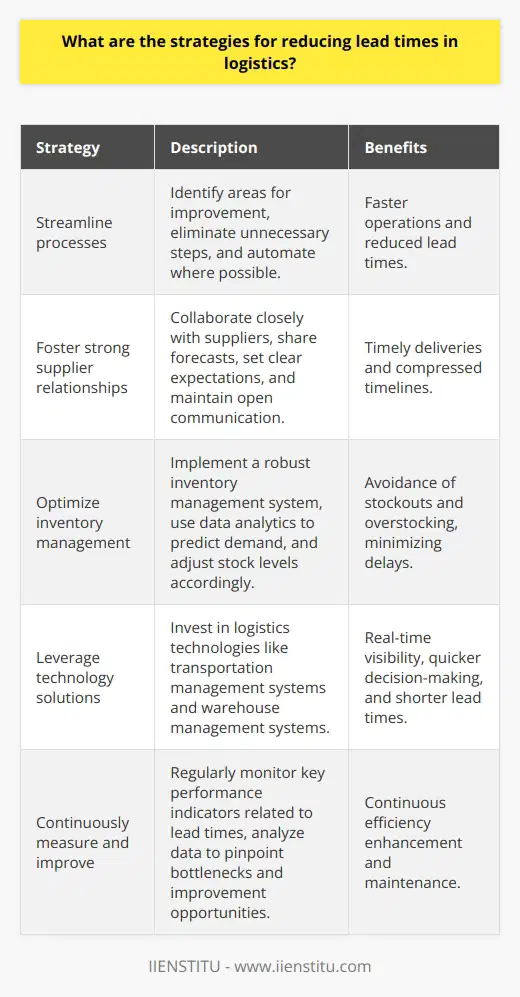
How do you handle logistics in a global supply chain?
When it comes to handling logistics in a global supply chain, I rely on a combination of strategies. First and foremost, I prioritize clear communication with all stakeholders involved in the process.
Building Strong Relationships
I invest time in building strong relationships with suppliers, manufacturers, and distributors across different countries. By establishing trust and open lines of communication, I can more effectively coordinate logistics and troubleshoot any issues that arise.
Leveraging Technology
I leverage technology to streamline logistics management. Tools like supply chain management software, real-time tracking systems, and data analytics help me optimize routes, monitor inventory levels, and make data-driven decisions.
Contingency Planning
In my experience, it's crucial to have contingency plans in place. I always prepare for potential disruptions such as weather events, port congestion, or geopolitical issues. By having alternative routes and backup suppliers ready, I can minimize the impact on the supply chain.
Continuous Improvement
I believe in continuously improving logistics processes. I regularly review performance metrics, seek feedback from team members and partners, and stay up-to-date with industry best practices. By adopting a proactive approach to logistics management, I can identify opportunities for optimization and implement changes that drive efficiency.
At the end of the day, handling logistics in a global supply chain requires a strategic mindset, adaptability, and a willingness to collaborate with others. It's a challenging but rewarding aspect of my work that I thoroughly enjoy.
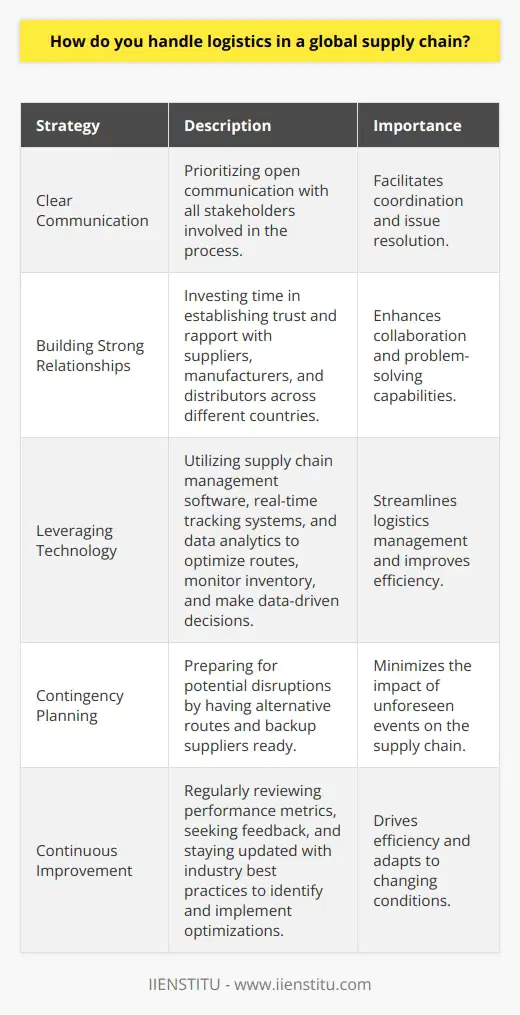
What is the importance of collaboration in logistics management?
Collaboration is crucial in logistics management because it enables seamless coordination among various stakeholders involved in the supply chain. <h4>Enhancing Efficiency</h4> <p>When teams work together, they can streamline processes, reduce duplication of efforts, and optimize resource allocation. This leads to increased efficiency and faster turnaround times.
Improving Communication
Effective collaboration facilitates clear and open communication channels, ensuring that everyone is on the same page. This helps prevent misunderstandings and delays, keeping the logistics operations running smoothly.
Fostering Innovation
Collaborating with diverse team members brings together different perspectives, skills, and ideas. This creates an environment that encourages innovation and problem-solving, leading to the development of new strategies and solutions.
Strengthening Relationships
Building strong relationships with suppliers, carriers, and customers is essential in logistics management. Collaboration helps establish trust, mutual understanding, and long-term partnerships that benefit all parties involved.
In my experience, I've seen how collaboration can transform logistics operations. I once worked on a project where we needed to optimize our warehouse layout. By bringing together team members from different departments, we were able to come up with a creative solution that not only improved efficiency but also enhanced safety. It was a testament to the power of collaboration.
To sum up, collaboration is the glue that holds logistics management together. It fosters efficiency, communication, innovation, and strong relationships, ultimately leading to success in this dynamic and fast-paced industry.
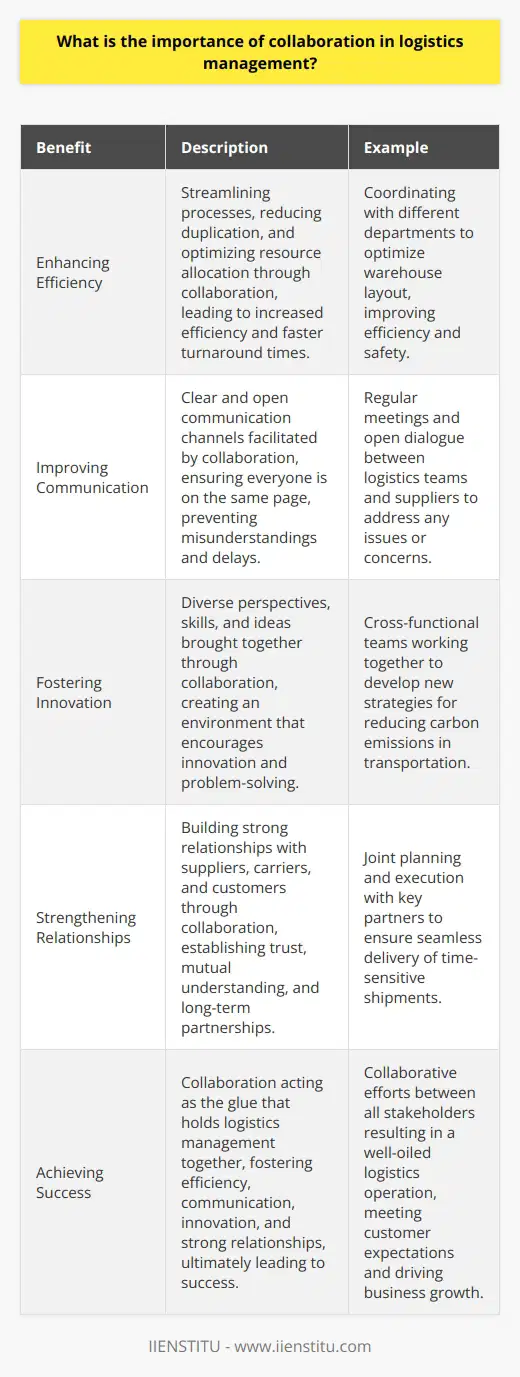
How do you ensure compliance with regulations in logistics operations?
Ensuring compliance with regulations in logistics operations is a critical responsibility. Here are some key strategies I employ:
Staying Up-to-Date
I make it a priority to stay current on all relevant regulations and industry standards. This involves regularly reviewing updates from regulatory bodies and participating in training sessions to deepen my understanding.
Developing Compliance Checklists
To maintain a high level of compliance, I create detailed checklists that cover all necessary requirements. These checklists serve as a valuable reference tool for my team and help ensure nothing gets overlooked.
Conducting Regular Audits
I schedule frequent internal audits to assess our compliance levels and identify any potential gaps. By proactively monitoring our operations, we can quickly address any issues before they become significant problems.
Collaborating with Stakeholders
Maintaining open lines of communication with stakeholders, such as suppliers and customers, is essential. I work closely with them to ensure their practices align with our compliance standards and regulatory obligations.
Empowering Employees
I believe in empowering my team with the knowledge and tools they need to uphold compliance. Through comprehensive training programs and clear guidelines, I enable them to make informed decisions that adhere to regulations.
By implementing these strategies consistently and fostering a culture of compliance, I strive to ensure our logistics operations remain fully compliant at all times.

What are the skills required for effective logistics management?
As a logistics manager with over a decade of experience, I believe several key skills are essential for success in this role.
Organizational Skills
A logistics manager must be highly organized and detail-oriented. They need to juggle multiple tasks and priorities simultaneously.
Time Management
Effective time management is crucial. Logistics managers have to meet tight deadlines and coordinate complex schedules.
Communication Skills
Clear communication, both written and verbal, is vital. Logistics managers interact with people at all levels of an organization.
Leadership Abilities
Strong leadership skills are a must. Logistics managers oversee teams and need to motivate and guide their staff.
Problem-Solving Skills
Creative problem-solving is essential in logistics. I've faced many challenges that required quick thinking and innovative solutions.
Adaptability
Logistics managers need to be flexible and adaptable. Supply chains are dynamic and conditions can change rapidly.
Technical Proficiency
Familiarity with logistics software, databases, and analytics tools is important. Technology plays a huge role in modern logistics.
Ultimately, a successful logistics manager combines strong soft skills with technical know-how. It's a challenging but rewarding career for the right person.
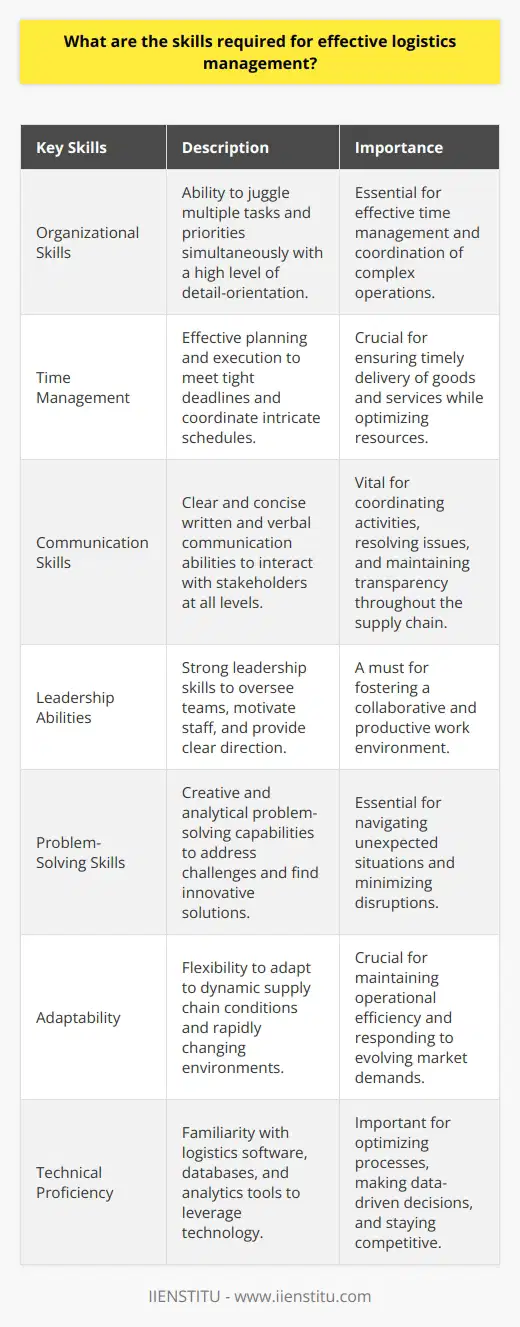
How do you continuously improve logistics processes?
Embracing Continuous Improvement
I believe that continuously improving logistics processes is essential for staying competitive and efficient. In my experience, it starts with fostering a culture of continuous improvement within the team. Encouraging everyone to look for opportunities to streamline processes and reduce waste is key.
Leveraging Technology and Data
I've found that leveraging technology and data analytics is crucial for identifying areas for improvement. By utilizing tools like warehouse management systems and transportation management systems, we can gain valuable insights into our operations. This data helps us make informed decisions and spot trends that may indicate inefficiencies.
Collaborating with Stakeholders
Collaborating with stakeholders across the supply chain is another important aspect of continuous improvement. By working closely with suppliers, carriers, and customers, we can identify pain points and develop solutions together. I've seen firsthand how fostering strong partnerships can lead to mutually beneficial process improvements.
Implementing Lean Principles
Implementing lean principles, such as eliminating waste and optimizing flow, is also critical. I've had success with techniques like value stream mapping to identify bottlenecks and streamline processes. By constantly looking for ways to reduce non-value-added activities, we can improve efficiency and reduce costs.
Measuring and Monitoring Performance
Finally, measuring and monitoring performance is essential for tracking progress and identifying further opportunities for improvement. Setting clear key performance indicators (KPIs) and regularly reviewing them helps keep everyone focused on continuous improvement. I believe that by constantly monitoring and adjusting our processes, we can stay ahead of the curve and deliver exceptional results.
